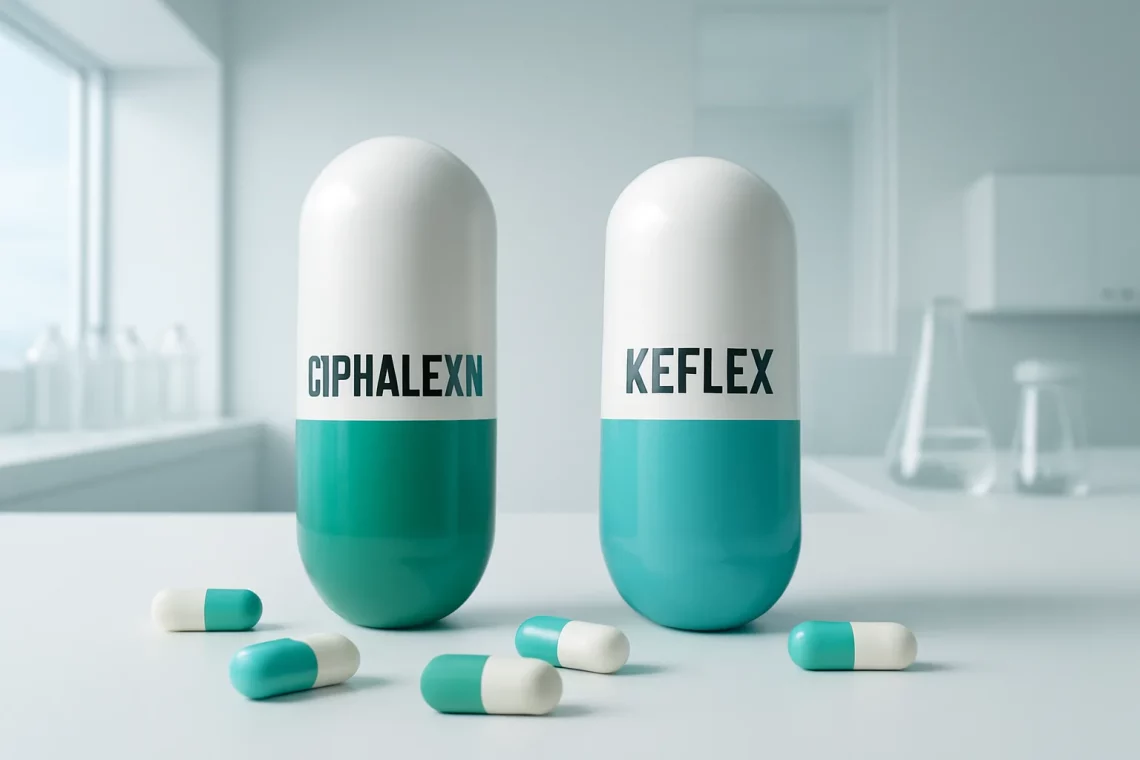
Cephalexin vs Keflex: Understanding Their Differences and Uses
Cephalexin and Keflex are two terms that often arise in discussions about antibiotic treatments. For many, the distinction between these two names may seem trivial, but understanding the nuances can be crucial for effective treatment. Cephalexin is the generic name for a specific antibiotic that is classified as a cephalosporin. On the other hand, Keflex is a brand name under which cephalexin is marketed. This distinction is essential for patients and healthcare providers alike, as it influences prescription practices and patient education.
Antibiotics like cephalexin play a vital role in modern medicine, helping to combat bacterial infections that can range from mild to severe. They work by interfering with the bacteria’s ability to form cell walls, ultimately leading to the bacteria’s death. However, the increasing prevalence of antibiotic resistance has made it imperative for both patients and healthcare providers to understand different antibiotics’ specific uses, side effects, and overall effectiveness.
It is equally crucial to consider the broader implications of antibiotic use, including the importance of adhering to prescribed dosages and completing the entire course of treatment. Misuse or overuse of antibiotics can lead to resistance, making it more challenging to treat infections in the future. By examining cephalexin and its brand counterpart, Keflex, one can gain a deeper understanding of antibiotic therapy and its pivotal role in healthcare.
Understanding Cephalexin
Cephalexin is a first-generation cephalosporin antibiotic that is widely used to treat a variety of bacterial infections. It is particularly effective against Gram-positive bacteria, including strains of streptococcus and staphylococcus. This makes it a common choice for treating skin infections, respiratory infections, and urinary tract infections, among others.
The mechanism of action for cephalexin involves the inhibition of bacterial cell wall synthesis. By disrupting the formation of the cell wall, cephalexin ultimately causes the bacteria to burst and die. This makes it a potent option for combating infections caused by susceptible bacteria.
Cephalexin is available in various forms, including capsules, tablets, and liquid suspension, making it accessible for different patient needs. The dosage and duration of treatment typically depend on the specific type of infection being treated, the severity of the infection, and the patient’s overall health. For instance, a mild skin infection might require a shorter course of treatment than a more severe urinary tract infection.
Like all medications, cephalexin comes with potential side effects. Common side effects may include gastrointestinal issues such as nausea, vomiting, and diarrhea. In some cases, patients may also experience allergic reactions, which can range from mild rashes to more severe reactions like anaphylaxis. It is important for patients to inform their healthcare providers of any previous allergic reactions to antibiotics, as this can influence treatment decisions.
In summary, cephalexin is a widely-used antibiotic that has proven effective in treating various bacterial infections. Its ability to effectively disrupt bacterial cell walls makes it a valuable tool in the fight against infections. However, as with any medication, it is essential to use cephalexin responsibly and under the guidance of a healthcare professional.
Keflex: The Brand Name
Keflex is the brand name for cephalexin, and it is manufactured by various pharmaceutical companies. The branding of medications serves several purposes, including easier recognition for both healthcare providers and patients. While the active ingredient remains the same—cephalexin—the branding can influence perceptions of quality and effectiveness.
Brand-name medications like Keflex often come with a higher price tag compared to their generic counterparts. This price difference is primarily due to the costs associated with research, development, marketing, and branding. However, it is essential to understand that the active ingredient, cephalexin, in both the brand and generic version is chemically identical and should produce the same therapeutic effects when dosed appropriately.
Keflex is commonly prescribed for bacterial infections, including those affecting the skin, respiratory tract, and urinary system. Given its effectiveness, many healthcare providers opt for Keflex when they need a reliable antibiotic treatment. The prescribing decision may also be influenced by patient preferences, insurance coverage, and previous treatment experiences.
The formulation of Keflex is similar to that of cephalexin, available in oral forms such as capsules and liquid suspensions. This accessibility ensures that patients can choose a formulation that best suits their needs. The dosing guidelines for Keflex align with those for cephalexin, making it easy for healthcare providers to switch between the two when necessary.
As with any medication, patients taking Keflex should be aware of possible side effects. These can include gastrointestinal disturbances, allergic reactions, and, in rare cases, more severe side effects such as liver problems. It is crucial for patients to discuss their medical history with their healthcare provider to ensure that Keflex is a safe option for them.
In conclusion, Keflex serves as a brand name for cephalexin, providing an effective option for treating bacterial infections. While the active ingredient remains the same, the branding can affect patient perceptions and prescribing practices. By understanding the relationship between cephalexin and Keflex, patients can make informed choices about their antibiotic treatments.
Comparative Effectiveness and Uses
When considering the effectiveness of cephalexin and its brand counterpart, Keflex, it is essential to recognize that the active ingredient remains the same. Both options are equally effective in treating a variety of bacterial infections. The choice between the two often comes down to factors such as cost, availability, and patient preference.
Both cephalexin and Keflex are used to treat infections caused by susceptible bacteria. This includes skin infections, respiratory infections like pneumonia, and urinary tract infections. The choice of which antibiotic to prescribe typically depends on the specific type of infection, the severity of symptoms, and the patient’s medical history.
In clinical practice, healthcare providers may have a preference for brand-name medications like Keflex due to perceived reliability or familiarity. However, many patients may opt for the generic version to save on costs, particularly if they have to pay for their medications out of pocket. It is worth noting that insurance plans often have different coverage policies for generic and brand-name medications, which can influence patient choices.
From an effectiveness standpoint, studies have consistently demonstrated that both cephalexin and Keflex yield similar clinical outcomes when used to treat infections. This consistent performance underscores the importance of patient adherence to prescribed dosages and treatment duration, regardless of the brand name.
Another critical consideration in the discussion of these two antibiotics is the development of antibiotic resistance. Both cephalexin and Keflex should be used judiciously to minimize the risk of resistance. Patients should always complete the prescribed course of antibiotics, even if symptoms improve before finishing the medication. This adherence helps ensure that the bacteria are entirely eradicated and reduces the risk of developing resistance.
In summary, both cephalexin and Keflex offer effective treatment options for various bacterial infections. The choice between the two often hinges on factors such as cost, availability, and patient preference. Regardless of which version is chosen, responsible use and adherence to prescribed guidelines are crucial to ensuring effective treatment and minimizing the risk of antibiotic resistance.
Side Effects and Precautions
Like all medications, both cephalexin and Keflex come with a range of potential side effects. Understanding these side effects is essential for patients to make informed decisions about their treatment. Common side effects associated with these antibiotics include gastrointestinal issues, such as nausea, diarrhea, and abdominal pain. These symptoms can often be managed by taking the medication with food or adjusting the dosage as recommended by a healthcare provider.
In addition to gastrointestinal side effects, allergic reactions can occur in some patients. Symptoms of an allergic reaction can range from mild rashes to more severe complications. If a patient experiences hives, difficulty breathing, or swelling of the face or throat, it is crucial to seek immediate medical attention. Patients should always inform their healthcare provider of any known allergies, particularly to antibiotics, as this information is vital for safe prescribing.
Other potential side effects may include headache, dizziness, and fatigue. While these side effects are generally not severe, they can impact a patient’s daily activities. It is essential for patients to communicate any concerning symptoms to their healthcare provider, who can provide guidance on how to manage these side effects.
Patients with specific medical conditions may need to take additional precautions when using cephalexin or Keflex. For instance, individuals with a history of kidney disease may require dosage adjustments to prevent complications. Pregnant or breastfeeding women should also consult their healthcare provider to ensure that these antibiotics are safe for their specific situation.
Furthermore, it is important to note that antibiotic use can disrupt the natural balance of gut bacteria, leading to conditions such as antibiotic-associated diarrhea or Clostridium difficile infection. Patients should be vigilant for any significant changes in bowel habits during or after treatment and report them to their healthcare provider.
In conclusion, while both cephalexin and Keflex are effective antibiotics, they are not without their potential side effects and precautions. Patients should be fully aware of the risks associated with these medications and communicate openly with their healthcare provider to ensure safe and effective treatment.
**Disclaimer:** This article is intended for informational purposes only and does not constitute medical advice. Always consult a healthcare professional for medical concerns or questions regarding treatment options.




